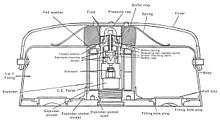Mk 2 mine
The Mark II mine or A./T. Mine G.S. Mk II was a British anti-tank blast mine used during the Second World War. It consisted of a body about seven inches (18 cm) in diameter and two inches high (5 cm). The mine has a central fuze well accessed from the bottom, with a main charge in a cavity around the well consisting of about 4 pounds (1.8 kg) of TNT. The mine is fitted with a thin brass cover, which acts as a pressure plate. The cover is suspended over the main body of the main by four leaf springs. A Sorbo ring made of Sorbo rubber can be fitted between the cover and the mine body, which absorbs shock and blast and allows the mines to be planted as close as two feet (61 cm) without causing sympathetic detonation (normally five feet is the minimum safe distance).

Sufficient pressure on the cover of the mine causes the cover to press downward onto the pressure cap of the fuze. This downward pressure forces the assembly surrounding the striker down until the striker retaining balls are aligned with a cavity. The balls are pushed aside and the striker is released impacting the detonator which detonates the C.E. pellet, triggering the exploder and then the main charge.
The mines main charge was relatively small and the mine appears to have been withdrawn by the end of the war, being replaced by the larger Mk 5 mine. However, the mine was used in large numbers at the Battle of El-Alamein.[1]
Specifications
- Diameter: 7 1⁄2 inches (19 cm)
- Height: 3 1⁄4 inches (8.3 cm) with cover
- Weight: 8.5 lb (3.9 kg)
- Operating force: 350 lbf (1.56 kN)
- Explosive content: 4 lb of TNT (1.8 kg) or Baratol
References
- Anti-tank mines, Military Training Pamphlet No. 40 (1942), The War Office.
- NAVORD OP 1665, British Explosive Ordnance, Naval Ordnance Systems Command (Updated 1970)